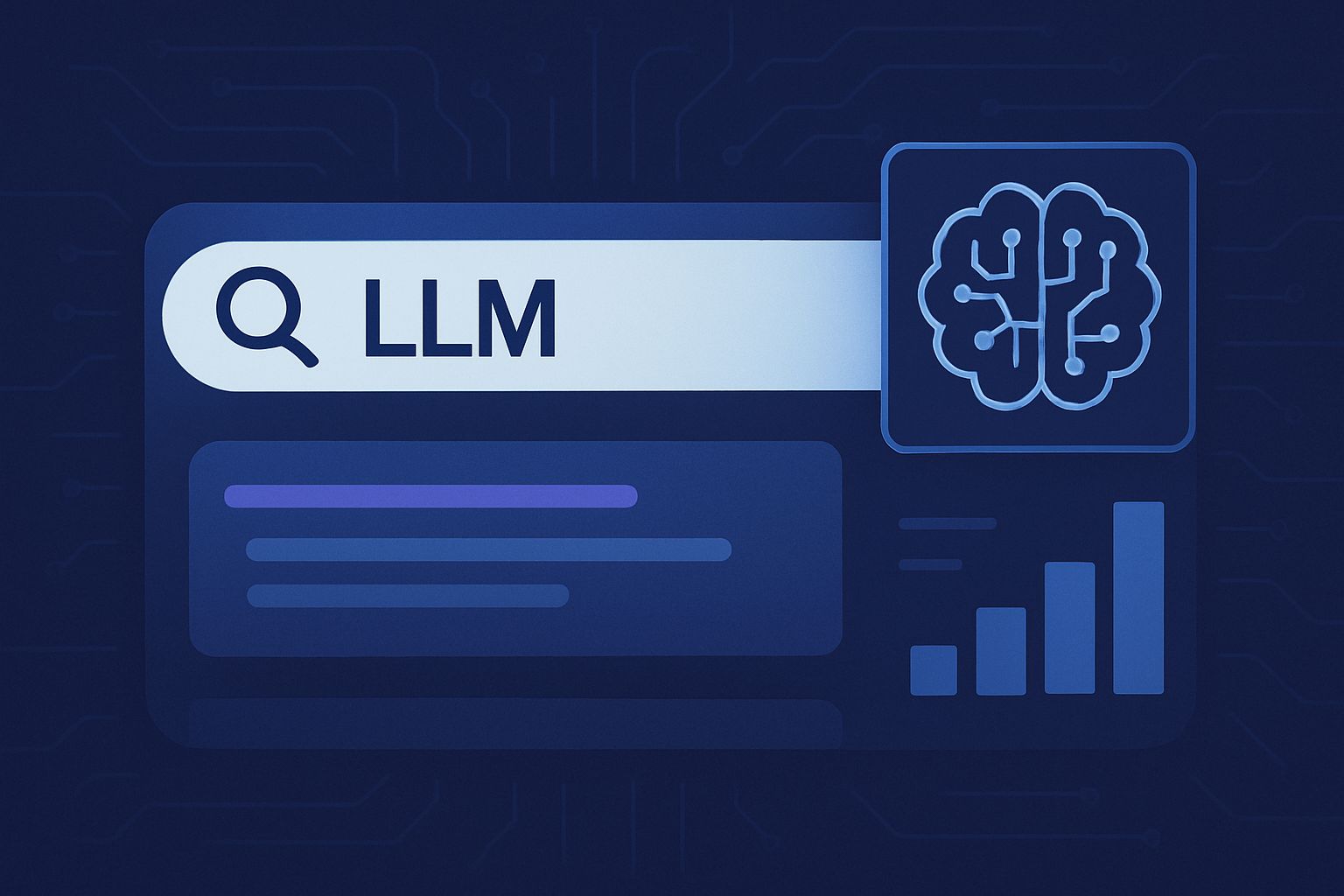Introduction: From Keywords to Conversations

Imagine asking your phone, "What's the best hiking trail within an hour of here that's not too crowded and has a lake view?" or typing "Help me write a heartfelt apology email to my team." Not long ago, search engines would have fumbled with these requests, parsing only a few keywords and hoping for the best. But today, with the help of Large Language Models (LLMs), search can interpret these questions in full context and provide highly relevant responses—sometimes generating the answer outright.
This transformation is revolutionizing the way we interact with technology. Search engines are no longer just tools for retrieving documents based on exact word matches. Thanks to the rise of AI models like OpenAI's GPT, Google's Gemini, and Meta's LLaMA, they're evolving into intelligent assistants that understand nuance, conversation, and intent.
In this new era, the question is no longer "What keywords should I type to get the right answer?" but "How can I ask my question naturally and get exactly what I need?" Whether you’re a student looking for research summaries, a developer debugging an obscure error, or a traveler planning a weekend getaway, LLMs are making search more human. This article explores how LLMs are changing the architecture of modern search engines, focusing on three critical components: query understanding, retrieval, and ranking.
1. Query Understanding: Moving Beyond Keywords
Traditional search engines treat queries as bags of words. They apply stemming, synonym expansion, and simple rules to interpret intent. However, this approach breaks down with ambiguous, complex, or conversational queries. Enter LLMs.
LLMs enable deep semantic understanding. They can analyze a user query in full context, resolving ambiguity, understanding nuances, and even detecting underlying intent. For instance, consider the query: "Best budget phone for photography under $300." A traditional system might struggle with the composite intent (budget + photography + price range). An LLM, however, can parse these dimensions and provide a richer query representation.
Technically, this is done using embedding models that convert queries into dense vectors capturing semantic meaning. Modern systems often use fine-tuned transformer models (e.g., BERT, T5, or domain-specific LLMs) to produce these embeddings. This allows the engine to match intent rather than exact terms, making search much more effective for natural language queries.
LLMs also assist in query rewriting and expansion. They can paraphrase or elaborate vague queries, such as transforming "laptop good for travel" into "lightweight and durable laptops with long battery life for frequent travelers."
2. Retrieval: Smarter Document Matching at Scale
Once the system understands the query, it must retrieve relevant documents. Traditional retrieval relies on inverted indexes and term-frequency methods (e.g., BM25). These approaches are fast but often miss semantically relevant content that doesn't share keywords.
LLMs have inspired a new wave of neural retrieval models. Dense retrieval methods use dual-encoder architectures: one encoder for the query and another for documents. Both are trained to produce embeddings such that semantically similar pairs are close in vector space. Retrieval is then a nearest-neighbor search in this space, often accelerated with vector databases like FAISS or ScaNN.
Some systems combine lexical and neural retrieval, a hybrid method that balances precision and recall. For example, ColBERT (Contextualized Late Interaction over BERT) retains efficiency while capturing fine-grained interactions between queries and documents.
LLMs are also being used for "generative retrieval" where, instead of just finding documents, the model can suggest potential relevant facts or links by generating text directly. While not yet a full replacement for retrieval, this technique shows promise for query suggestion, autocomplete, and handling rare or novel information needs.
3. Ranking: Predicting the Best Answers with Deep Semantics
Ranking determines the order in which results are shown. Traditionally, this relies on hand-crafted features: keyword overlap, link authority, click-through rates. But LLMs allow for a much richer, data-driven ranking pipeline.
Modern ranking systems now use transformer-based models (often cross-encoders) to evaluate the relationship between the query and candidate documents. Unlike dual-encoders used in retrieval, cross-encoders take both query and document together as input and perform deep interaction modeling. This enables highly accurate scoring but comes with higher computational cost.
To mitigate this, search engines adopt multi-stage ranking:
- First-pass retrieval using BM25 or dual-encoders to fetch top-N candidates.
- Re-ranking using cross-encoders to deeply score and order these candidates.
LLMs are also being integrated for answer generation and snippet creation. Instead of selecting a web page, the engine can now generate a direct answer, citing its sources. This approach powers features like Google's AI Overviews and Bing's Copilot, where the engine blends retrieval and generation for a conversational experience.
Putting It All Together: A New Search Stack
The integration of LLMs redefines the entire search stack:
- Pre-processing: LLMs normalize and enrich user queries.
- Retrieval: Dense embeddings from LLMs enable better semantic search.
- Ranking: Cross-encoders deeply evaluate relevance.
- Answering: Generative models synthesize responses.
This architecture not only improves result relevance but also supports new experiences like conversational search, multimodal search (text + image), and proactive suggestions.
Challenges and Considerations
Despite their promise, LLMs introduce new challenges:
- Latency and cost: Transformer models are computationally expensive.
- Scalability: Running LLMs at web scale requires infrastructure optimization.
- Factual accuracy: Generative answers can hallucinate facts if not grounded in reliable sources.
- Bias and safety: LLMs can reflect societal biases and need guardrails for sensitive topics.
Companies are addressing these through techniques like knowledge grounding, retrieval-augmented generation (RAG), model distillation, and AI alignment tools.
Conclusion: Towards a Smarter, More Human Web
Search is no longer about just finding documents. It’s about understanding intent, retrieving insights, and delivering answers in the most helpful way possible. Large Language Models are making this vision a reality, turning search engines into intelligent companions that can understand and converse with us.
This shift also democratizes information access. Non-technical users can now express their needs in natural language and receive answers that are contextually appropriate and easy to digest. LLM-powered search brings accessibility to users across languages, literacy levels, and even disabilities, making the internet more inclusive.
For businesses, this opens up new dimensions in customer support, product discovery, and user engagement. For researchers and professionals, it streamlines the path from question to insight. And for everyone, it brings us closer to a world where information feels more like a dialogue and less like a scavenger hunt.
As LLMs continue to evolve in accuracy, efficiency, and safety, the future of search looks brighter, smarter, and more attuned to how humans think and communicate.
References
- Devlin, J., Chang, M. W., Lee, K., & Toutanova, K. (2019). BERT: Pre-training of Deep Bidirectional Transformers for Language Understanding. arXiv preprint arXiv:1810.04805.
- Khattab, O., & Zaharia, M. (2020). ColBERT: Efficient and Effective Passage Search via Contextualized Late Interaction over BERT. Proceedings of the 43rd International ACM SIGIR.
- Karpukhin, V., et al. (2020). Dense Passage Retrieval for Open-Domain Question Answering. arXiv preprint arXiv:2004.04906.
- OpenAI. (2023). GPT-4 Technical Report. https://openai.com/research/gpt-4.
- Google DeepMind. (2024). Gemini: A Multimodal Model for AI Integration. https://deepmind.google.
- Facebook AI. (2023). LLaMA: Open Foundation Models. https://ai.facebook.com/blog/large-language-model-llama.
- Raffel, C., et al. (2020). Exploring the Limits of Transfer Learning with a Unified Text-to-Text Transformer. JMLR.
- Lin, J., Ma, X., & Liu, Y. (2021). Pretrained Transformers for Text Ranking: BERT and Beyond. arXiv:2102.10056.
- Lewis, P., et al. (2020). Retrieval-Augmented Generation for Knowledge-Intensive NLP Tasks. NeurIPS.
- Microsoft. (2024). Bing AI Copilot Overview. https://blogs.microsoft.com







